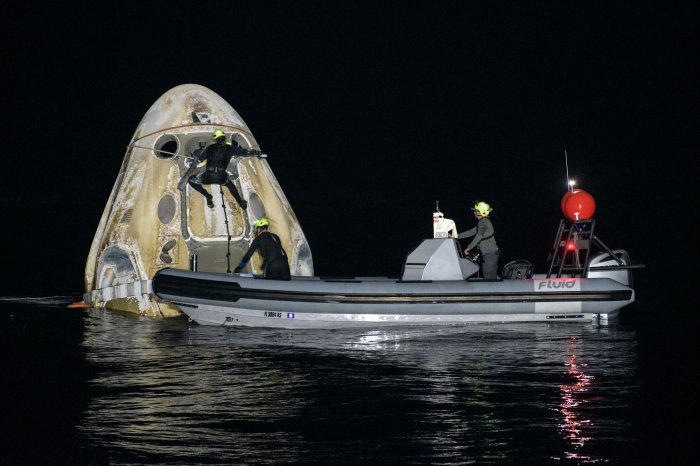1 of 4 | The SpaceX SN-10 prototype of the Starliner rocket lifts off on a test flight early Wednesday evening from Boca Chica, Texas. Photo courtesy of SpaceX |
License Photo
March 3 (UPI) -- Elon Musk's SpaceX notched the first upright landing of the company's deep-space Starship rocket after a test flight early Wednesday evening in Boca Chica, Texas -- but the rocket exploded minutes later.
A live feed showed the stainless steel rocket soaring above the South Texas shoreline, flipping over and decelerating to a gentle touchdown at a slight angle on the landing pad.
But a fire broke out at the base of the rocket, which minutes later collapsed in a fireball, with no immediate explanation from the company.
The test rocket, named SN10, flew about 6 miles overhead in the third test for Starship. Two previous test flights also ended in fiery explosions, but those fireballs occurred upon landing.
"As we approached the landing pad, we successfully lit the three Raptor engines to perform that flip maneuver," John Insprucker, a principal engineer at SpaceX, said in a live broadcast.
"And then we shut down two of them, and landed on the single engine as planned. A beautiful soft landing of a starship on the landing pad in Boca Chica," he said.
Earlier Wednesday, SpaceX aborted a launch attempt just as the countdown reached liftoff time. Musk said on Twitter the abort occurred because of a "slightly conservative thrust limit" on one of the rocket's three Raptor engines. That limit was reset.
Two previous tests, in December and February, ended with test rockets crashing on the landing pad. During the February test, one of the engines failed to ignite properly, but such failures are not necessarily a setback, according to the company.
That's because SpaceX has gathered data about the craft as it tests, Insprucker said.
The Federal Aviation Administration found that the December test had violated the company's license and hadn't been approved. Since then, SpaceX investigated the decision to fly in December and agreed to undisclosed corrective actions.
The rocket has four flaps or small wings that move to direct airflow and steer the vehicle as it descends, according to the SpaceX test flight description.
"All four flaps are [controlled] by an onboard flight computer to control Starship's attitude [orientation] during flight and enable precise landing at the intended location," the company said.
A controlled descent of the rocket is "critical to landing Starship at destinations across the solar system where prepared surfaces or runways do not exist, and returning to Earth," SpaceX said.
The test follows an announcement Tuesday by Japanese billionaire Yusaku Maezawa that he plans to take eight private citizens with him on a Starship flight around the moon in 2023.
Musk said Tuesday that Starship should be certified for human travel by then and will have reached orbit successfully "many, many times" by then.
The test rocket produces about 1.5 million pounds of thrust, just a little less than a Falcon 9 at about 1.7 million pounds. Eventually, Starship would have many more engines and more thrust.
Support teams work around the SpaceX Crew Dragon Resilience spacecraft shortly after it landed with NASA astronauts Mike Hopkins, Shannon Walker and Victor Glover and Japan Aerospace Exploration Agency astronaut Soichi Noguchi aboard in the Gulf of Mexico off Panama City, Fla., on Sunday. Photo by Bill Ingalls/NASA |
License Photo
















